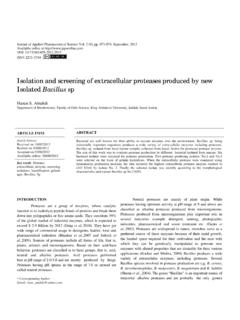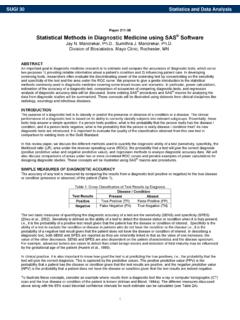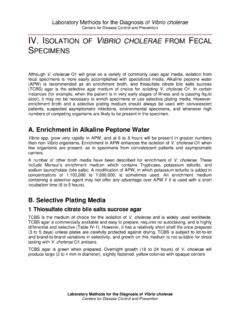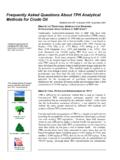Transcription of A Practical Guide to Prescribing Hormone …
1 DISEASE MANAGEMENT Drugs 1998 Jul; 56 (1): 49-57. 0012-6667/98/0007-0049/$ Adis International Limited. All rights reserved. A Practical Guide to Prescribing Hormone replacement therapy Karen A. McKinney and William Thompson Department of Obstetrics and Gynaecology, Queen's University of Belfast, Belfast, Northern Ireland Contents Abstract .. 49. 1. The First Clinic Attendance .. 50. Screening .. 50. 2. Contraindications to Postmenopausal Hormone replacement therapy (HRT) .. 50. Absolute Contraindications .. 50. Relative Contraindications .. 51. 3. Methods of HRT .. 51. Patches or Tablets? .. 52. Percutaneous Estrogen.
2 52. Local Estrogen .. 52. Estradiol Implants .. 53. Testosterone Implants .. 53. Tibolone .. 53. 4. Alternative Treatments for Vasomotor Symptoms .. 53. 5. Treating the Healthy Woman Who Wants HRT .. 54. Patients with a Uterus .. 54. Treating the Hysterectomised Woman .. 54. 6. Managing Common Adverse Effects .. 55. Progestogenic Adverse Effects .. 55. Estrogenic Adverse Effects .. 55. 7. Prolonged Usage of HRT .. 55. 8. The Future .. 55. 9. Conclusion .. 56. Abstract Over the past 20 years there has been increasing interest in the menopause and Hormone replacement therapy (HRT). More recently, postmenopausal HRT has been seen as a specific treatment for symptoms in the short term and preventative therapy in the long term.
3 Women must be counselled regarding the risks and benefits of HRT according to the best available evidence. The patient should also be actively involved in the decision regarding HRT therapy , which should then improve patient compliance. Generally, an appropriate regimen of HRT can be formulated for the majority of patients. Progestogen should be added to therapy in women with an intact uterus in a cyclical or continuous regimen. The management of common estro- genic and progestogenic adverse effects is important in improving compliance. At present, new drugs are being developed for the management of the menopause 50 McKinney & Thompson (selective estrogen receptor modulators and phytoestrogens).
4 Obviously, further research will be necessary to determine whether these drugs have advantages over regular HRT. By offering postmenopausal women HRT an attempt is made to optimise their physical and psychological well-being. However, HRT is not without adverse effects, the most worrying of which is the possible increase in breast cancer risk with long term use. However, with patient education efforts, treatment regimens acceptable to both patient and practitioner can be initiated; in this regard, the aim of the practitioner should be to help the menopausal woman make the decision which is the most appropriate for her.
5 Over the past 20 years there has been enormous Screening interest in both the menopause and Hormone re- placement therapy (HRT). Most recently, the role Patients are advised to have 3-yearly mammog- of the menopause in the aetiology of major age- raphy screening, which is offered after the age of related disease in women has become apparent. 50 years in the UK. Older women (>64 years) are Postmenopausal HRT can be seen as a specific outside the screening programme and should be ad- treatment for symptoms in the short term and pre- vised to continue with the 3-yearly screening pro- ventative therapy in the long term.
6 The perception gramme. of the menopause as a problematic time for almost all women is changing and it seems that it is no 2. Contraindications to longer viewed as a negative experience by the ma- Postmenopausal Hormone jority of women.[1] Unfortunately, data from replacement therapy (HRT). randomised, controlled clinical trials on the impact of HRT on women's health are still lacking. To this Absolute Contraindications end, we await the completion of the Women's Absolute contraindications to HRT are rare, and Health Initiative in the US and the Medical Re- many patients are told that they must not receive search Council trial which has just commenced in such therapy when this is not actually the case.
7 Se- the UK. Definitive answers on questions such as verely impaired liver function and acute vascular the possibility of increased breast cancer risk in disease (including embolus and thrombosis). patients on long term HRT should then be avail- should be considered as absolute contraindications able. Until that time, treatment recommendations to HRT. Women with slight or moderate impair- are based on results from observational studies. ment of liver function may benefit from HRT as they are at higher risk of osteoporosis (due to de- 1. The First Clinic Attendance creased bone formation and less commonly osteo- malacia) as well as elevated cholesterol (especially At initial assessment women must be counselled cholestatic liver disease).
8 [2] Women who are het- regarding the risks and benefits of HRT based on erozygous for mutant factor V Leiden (approxi- the best available evidence. Physical examination, mately 6% of Caucasian women) have a 5-fold in- which should be carried out, should include height, creased risk of thrombosis (primarily venous). bodyweight, arterial blood pressure and breast and With the addition of HRT, the risk of thrombosis is pelvic examination, including cervical smear if in- increased to 50 times that of the general public and dicated. After discussion with the patient, a deci- is also associated with osteonecrosis.
9 [3,4] If fasting sion regarding HRT can be made. Close patient in- triglyceride levels are >500 mg/dl, estrogens volvement in that decision will improve patient should be avoided as the risk of acute pancreatitis compliance. is very high.[5]. Adis International Limited. All rights reserved. Drugs 1998 Jul; 56 (1). Prescribing Hormone replacement therapy 51. Relative Contraindications of the cancer may indicate that Hormone therapy can be used. However, even after this time period Close surveillance is indicated for patients with it would be difficult to actually confirm that there familial hyperlipidaemias and migraine head- would be no risk of recurrence and that HRT ad- aches.
10 Patients with migraine headaches often have ministration would be problem-free. A similar ap- reduced symptoms if a daily continuous combined proach should be used in patients previously estrogen/progestin HRT is used, eliminating a cy- treated for endometrioid tumours of the ovary. clic change in Hormone levels that may trigger In patients with previously treated breast cancer headaches. Serum lipid changes due to HRT ad- there is a lack of epidemiological evidence on the ministration are discussed in section 3. Conditions effects of HRT. Two small series in which women that do not represent contraindications include with previously treated breast cancer were given controlled hypertension, ischaemic heart disease, HRT indicated that the recurrence rate was no otosclerosis, obesity, benign breast disease, dia- greater than expected for the stage of their dis- betes mellitus and varicose veins.








